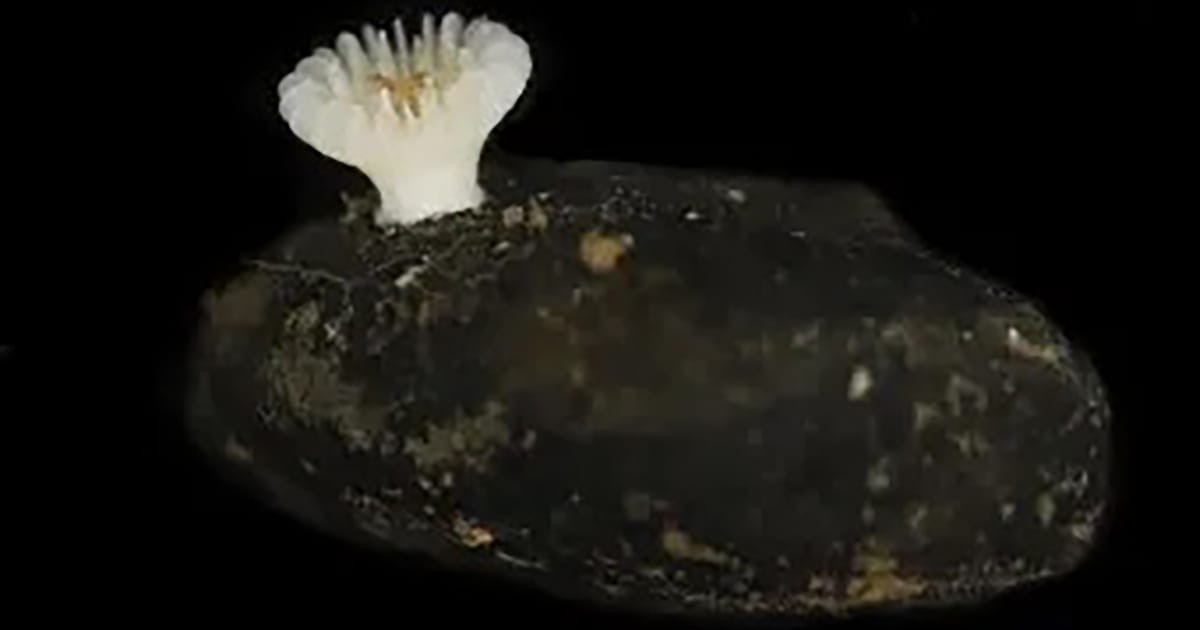The coral, Deltocyathus zoemetallicus—now described in a new study published in the Zoological Journal of the Linnean Society—was found more than 4,000 meters below the surface in the Clarion–Clipperton Zone (CCZ) of the Pacific Ocean. This is the first known hard-coral species to live directly on these nodules. The nodules grow extremely slowly—only a few millimeters over thousands of years. If mining were to remove them, this newly discovered species could lose its only known habitat—potentially before we fully understand its biology or ecological role.
The deep ocean floor was once thought to be flat, muddy, and largely lifeless; however, we now know it hosts a wide range of habitats and rich biodiversity. But the deep sea is also increasingly under threat, from challenges such as climate change, pollution, and deep-sea mining—underscoring the importance of continued research on deep-sea habitats and the species that reside within them.
The team of researchers has described a new species of azooxanthellate scleractinian coral in the deep eastern Pacific Ocean. Its name, Deltocyathus zoemetallicus, reflects the unique habitat of this animal—living directly attached to polymetallic nodules (zoemetallicus: zoe = life, metallicus = metal). The coral was discovered at depths between 4,150 and 4,250 meters in the Clarion–Clipperton Zone (CCZ), a vast stretch of seafloor between Hawaii and Mexico. The CCZ holds the world’s largest known deposits of polymetallic nodules—potato-sized lumps rich in manganese, nickel, cobalt, and other critical metals used in electric vehicle batteries and renewable energy technologies.
“This tiny coral is a hidden gem of the abyss,” said Dr. Nadia Santodomingo, the Head of Marine Invertebrates I Section at the Senckenberg Research Institute and Natural History Museum Frankfurt, and one of the researchers behind the discovery. “It lives directly on the nodules that mining companies are preparing to extract. If these nodules are removed, we risk wiping out an entire species we have only just found.”
Unlike shallow-water corals that often host symbiotic algae, which in return provide nutrients for the coral via sun-dependent photosynthesis, Deltocyathus zoemetallicus survives in total darkness. This species is an azooxanthellate scleractinian, meaning it lacks an algal partner to provide nutrients, instead feeding on particles that are drifting through the water. Using box corers during three expeditions onboard the OSV Maersk Launcher and one expedition on board the RRS James Cook, scientists carefully collected the new coral specimens and their nodule homes. The team then analyzed the animals using high-resolution imaging and 3D micro-CT scanning to confirm that it represents a species new to science.
Scleractinian corals, also known as stony corals, are marine animals that build hard skeletons made of calcium carbonate. While most people associate them with shallow tropical reefs, many species, such as Deltocyathus zoemetallicus, live in the deep sea, where sunlight never reaches. The deepest specimens of this new species were collected at a depth where calcium carbonate dissolves, known as the carbonate compensation depth. This means that they have to have special adaptations to be able to actively maintain their hard skeletons in waters this deep.
Corals of the genus Deltocyathus are found in every ocean basin except the Arctic and around Antarctica. They typically inhabit depths between 200 and 1,000 meters, with the deepest known species recorded at 5,080 meters. Most Deltocyathus species are free-living, meaning they sit lightly atop the seafloor sediments, with the exception of the Atlantic species Deltocyathus halianthus and now Deltocyathus zoemetallicus , which attach to hard substrates.
The newly discovered coral’s attachment to polymetallic nodules marks a unique ecological relationship—the first of its kind documented for any deep-sea scleractinian. Because nodules grow only a few millimeters every million years, removing them through mining would not only destroy the coral’s habitat but also eliminate the possibility of recolonization.
“This discovery underscores how little we know about life in the deep sea,” said Dr. Guadalupe Bribiesca-Contreras, lead author and Applied Scientist at NOC. “Every new species we find reminds us that the ocean floor is a living ecosystem and we still have so much research to do to explore and understand it fully.”
As governments and companies move closer to authorizing commercial mining in the CCZ, the discovery of D. zoemetallicus adds to the growing evidence that these abyssal ecosystems host unique, vulnerable, and still largely undiscovered biodiversity.
“Protecting these habitats is not just about saving one coral,” added Dr. Santodomingo. “It’s about preserving an entire world of deep-sea life that may vanish before we even know it exists.”
To read the publication, visit: https://doi.org/10.1093/zoolinnean/zlaf146
